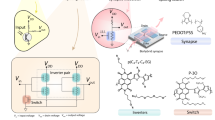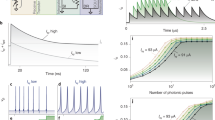Abstract
Software implementations of brain-inspired computing underlie many important computational tasks, from image processing to speech recognition, artificial intelligence and deep learning applications. Yet, unlike real neural tissue, traditional computing architectures physically separate the core computing functions of memory and processing, making fast, efficient and low-energy computing difficult to achieve. To overcome such limitations, an attractive alternative is to design hardware that mimics neurons and synapses. Such hardware, when connected in networks or neuromorphic systems, processes information in a way more analogous to brains. Here we present an all-optical version of such a neurosynaptic system, capable of supervised and unsupervised learning. We exploit wavelength division multiplexing techniques to implement a scalable circuit architecture for photonic neural networks, successfully demonstrating pattern recognition directly in the optical domain. Such photonic neurosynaptic networks promise access to the high speed and high bandwidth inherent to optical systems, thus enabling the direct processing of optical telecommunication and visual data.
This is a preview of subscription content, access via your institution
Access options
Access Nature and 54 other Nature Portfolio journals
Get Nature+, our best-value online-access subscription
$29.99 / 30 days
cancel any time
Subscribe to this journal
Receive 51 print issues and online access
$199.00 per year
only $3.90 per issue
Buy this article
- Purchase on Springer Link
- Instant access to full article PDF
Prices may be subject to local taxes which are calculated during checkout





Similar content being viewed by others
Data availability
All data used in this study are available from the corresponding author upon reasonable request.
References
Lane, N. D. et al. Squeezing deep learning into mobile and embedded devices. IEEE Pervasive Comput. 16, 82–88 (2017).
Amato, F. et al. Artificial neural networks in medical diagnosis. J. Appl. Biomed. 11, 47–58 (2013).
Nawrocki, R. A., Voyles, R. M. & Shaheen, S. E. A mini review of neuromorphic architectures and implementations. IEEE Trans. Electron Dev. 63, 3819–3829 (2016).
Preissl, R. et al. Compass: a scalable simulator for an architecture for cognitive computing. In Proc. Int. Conf. on High Performance Computing, Networking, Storage and Analysis (SC ’12) https://doi.org/10.1109/SC.2012.34 (IEEE, 2012).
von Neumann, J. The Computer and the Brain (Yale Univ. Press, 1958).
Wu, H., Yao, P., Gao, B. & Qian, H. Multiplication on the edge. Nat. Electron. 1, 8–9 (2018).
Furber, S. Bio-inspired massively-parallel computation. In Advances in Parallel Computing Vol. 27 Parallel Computing: On the Road to Exascale (IOS Press, 2018).
Schmitt, S. et al. Neuromorphic hardware in the loop: training a deep spiking network on the BrainScaleS wafer-scale system. In Proc. Int. Joint Conf. on Neural Networks 2227–2234 https://ieeexplore.ieee.org/document/7966125 (2017).
Shen, Y. et al. Deep learning with coherent nanophotonic circuits. Nat. Photon. 11, 441–446 (2017).
Vinckier, Q. et al. High-performance photonic reservoir computer based on a coherently driven passive cavity. Optica 2, 438–446 (2015).
Brunner, D., Soriano, M. C., Mirasso, C. R. & Fischer, I. Parallel photonic information processing at gigabyte per second data rates using transient states. Nat. Commun. 4, 1364–1367 (2013).
Ferreira de Lima, T., Shastri, B. J., Tait, A. N., Nahmias, M. A. & Prucnal, P. R. Progress in neuromorphic photonics. Nanophotonics 6, 577–599 (2017).
Vandoorne, K. et al. Experimental demonstration of reservoir computing on a silicon photonics chip. Nat. Commun. 5, 3541 (2014).
Cheng, Z., Ríos, C., Pernice, W. H. P., Wright, C. D. & Bhaskaran, H. On-chip photonic synapse. Sci. Adv. 2, e1700160 (2017).
Kim, S. et al. NVM neuromorphic core with 64k-cell (256-by-256) phase change memory synaptic array with on-chip neuron circuits for continuous in-situ learning. In Proc. International Electron Devices Meeting (IEDM) 17.1.1–17.1.4 (IEEE, 2015).
Kuzum, D., Jeyasingh, R. G. D., Lee, B. & Wong, H. P. Nanoelectronic programmable synapses based on phase change materials for brain-inspired computing. Nano Lett. 12, 2179–2186 (2012).
Wright, C. D., Liu, Y., Kohary, K. I., Aziz, M. M. & Hicken, R. J. Arithmetic and biologically-inspired computing using phase-change materials. Adv. Mater. 23, 3408–3413 (2011).
Pantazi, A., Woźniak, S., Tuma, T. & Eleftheriou, E. All-memristive neuromorphic computing with level-tuned neurons. Nanotechnology 27, 355205 (2016).
Lecun, Y., Bottou, L., Bengio, Y. & Haffner, P. Gradient-based learning applied to document recognition. Proc. IEEE 86, 2278–2324 (1998).
Burr, G. W. et al. Experimental demonstration and tolerancing of a large-scale neural network (165 000 synapses) using phase-change memory as the synaptic weight element. IEEE Trans. Electron Dev. 62, 3498–3507 (2015).
Le, Q. V. et al. Building high-level features using large scale unsupervised learning. In 29th Int. Conf. on Machine Learning https://dl.acm.org/citation.cfm?id=3042641 (2012).
Alduino, A. & Paniccia, M. Interconnects: wiring electronics with light. Nat. Photon. 1, 153–155 (2007).
Sun, C. et al. Single-chip microprocessor that communicates directly using light. Nature 528, 534–538 (2015).
Wuttig, M. & Yamada, N. Phase-change materials for rewriteable data storage. Nat. Mater. 6, 824–832 (2007).
Raoux, S., Xiong, F., Wuttig, M. & Pop, E. Phase change materials and phase change memory. MRS Bull. 39, 703–710 (2014).
Burr, G. W. et al. Recent progress in phase-change memory technology. IEEE J. Emerg. Sel. Top. Circuits Syst. 6, 146–162 (2016).
Tait, A. N., Nahmias, M. A., Shastri, B. J. & Prucnal, P. R. Broadcast and weight: an integrated network for scalable photonic spike processing. J. Lightwave Technol. 32, 3427–3439 (2014).
Tait, A. N. et al. Neuromorphic silicon photonic networks. Sci. Rep. 7, 7430 (2016).
Hebb, D. The Organization of Behaviour (Wiley, 1949).
Feldmann, J. et al. Calculating with light using a chip-scale all-optical abacus. Nat. Commun. 8, 1256 (2017).
Hahnloser, R. H. R., Sarpeshkar, R., Mahowald, M. A., Douglas, R. J. & Seung, H. S. Digital selection and analogue amplification coexist in a cortex-inspired silicon circuit. Nature 405, 947–951 (2000).
Bi, G. & Poo, M. Synaptic modification by correlated activity: Hebb’s postulate revisited. Annu. Rev. Neurosci. 24, 139–166 (2001).
Ríos, C. et al. Integrated all-photonic non-volatile multi-level memory. Nat. Photon. 9, 725–732 (2015).
Goldhahn, D., Eckart, T. & Quasthoff, U. Building large monolingual dictionaries at the Leipzig Corpora Collection: from 100 to 200 languages. In Proc. 8th Int. Conf. on Language Resources and Evaluation (LREC’12) http://www.lrec-conf.org/proceedings/lrec2012/pdf/327_Paper.pdf (2012).
Acknowledgements
This research was supported by EPSRC via grants EP/J018694/1, EP/M015173/1 and EP/M015130/1 in the UK and the Deutsche Forschungsgemeinschaft (DFG) grant PE 1832/5-1 in Germany. W.H.P.P. acknowledges support by the European Research Council through grant 724707. We acknowledge funding from the European Union’s Horizon 2020 research and innovation programme under grant agreement number 780848 (Fun-COMP).
Reviewer information
Nature thanks Geoffrey Burr, Ingo Fischer and the other anonymous reviewer(s) for their contribution to the peer review of this work.
Author information
Authors and Affiliations
Contributions
W.H.P.P., H.B. and C.D.W. conceived the experiment. J.F. fabricated the devices (with assistance from N.Y.). N.Y. performed the deposition of the GST material. J.F. implemented the measurement setup and carried out the measurements (with help from N.Y.). All authors discussed the data and wrote the manuscript together.
Corresponding author
Ethics declarations
Competing interests
The authors declare no competing interests.
Additional information
Publisher’s note: Springer Nature remains neutral with regard to jurisdictional claims in published maps and institutional affiliations.
Supplementary information
Supplementary Information
This file contains Supplementary Tables 2-4 and Supplementary Figures 1-2.
Rights and permissions
About this article
Cite this article
Feldmann, J., Youngblood, N., Wright, C.D. et al. All-optical spiking neurosynaptic networks with self-learning capabilities. Nature 569, 208–214 (2019). https://doi.org/10.1038/s41586-019-1157-8
Received:
Accepted:
Published:
Issue Date:
DOI: https://doi.org/10.1038/s41586-019-1157-8
This article is cited by
-
Quantum annealing-aided design of an ultrathin-metamaterial optical diode
Nano Convergence (2024)
-
Parity-time symmetry enabled ultra-efficient nonlinear optical signal processing
eLight (2024)
-
Reconfigurable optoelectronic transistors for multimodal recognition
Nature Communications (2024)
-
Reconfigurable memlogic long wave infrared sensing with superconductors
Light: Science & Applications (2024)
-
Compact eternal diffractive neural network chip for extreme environments
Communications Engineering (2024)
Comments
By submitting a comment you agree to abide by our Terms and Community Guidelines. If you find something abusive or that does not comply with our terms or guidelines please flag it as inappropriate.



